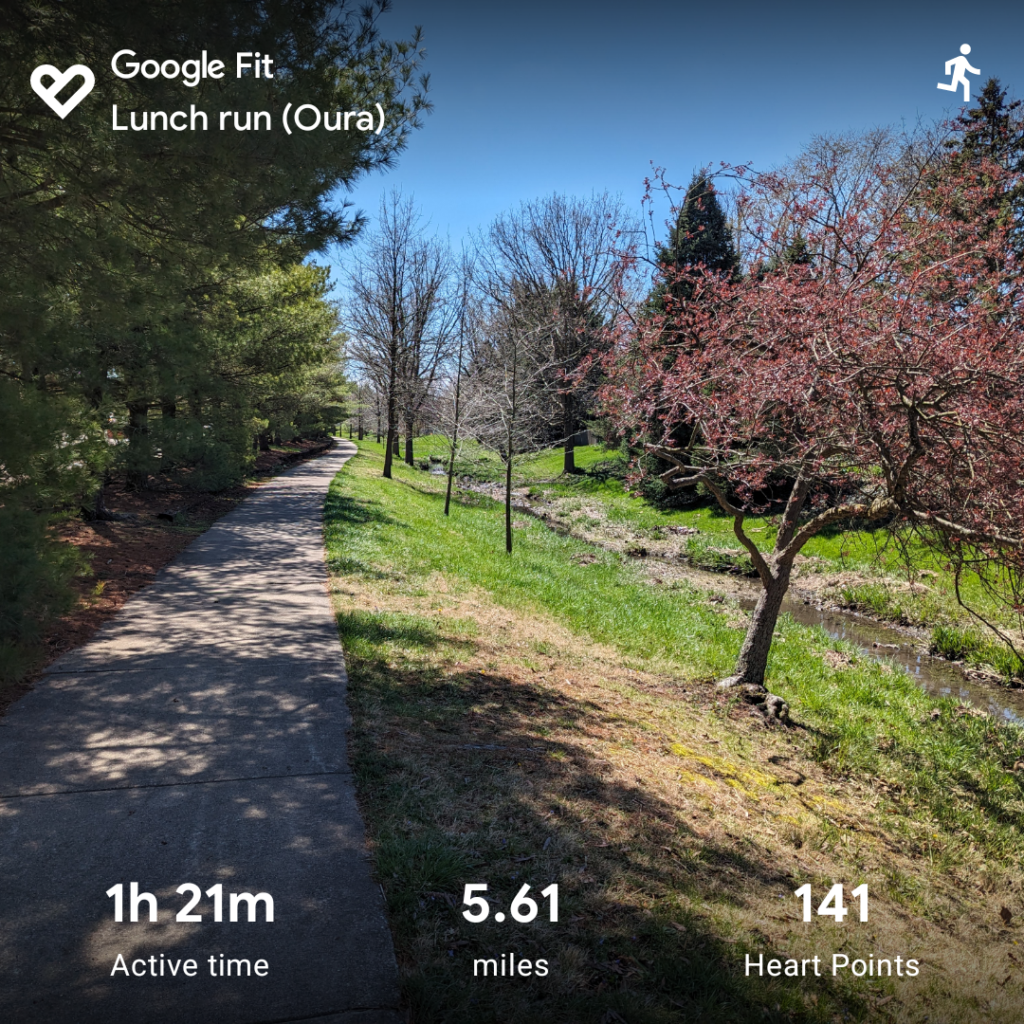Got in a very nice run today with Ashley, going 2.46 miles in (despite what the image says) 33:41. Ashley was a Very Good Dog on the run, despite just a little bit of grabbing the leash in her jaws after we turned back toward home. 🐕 🏃🏻♂️
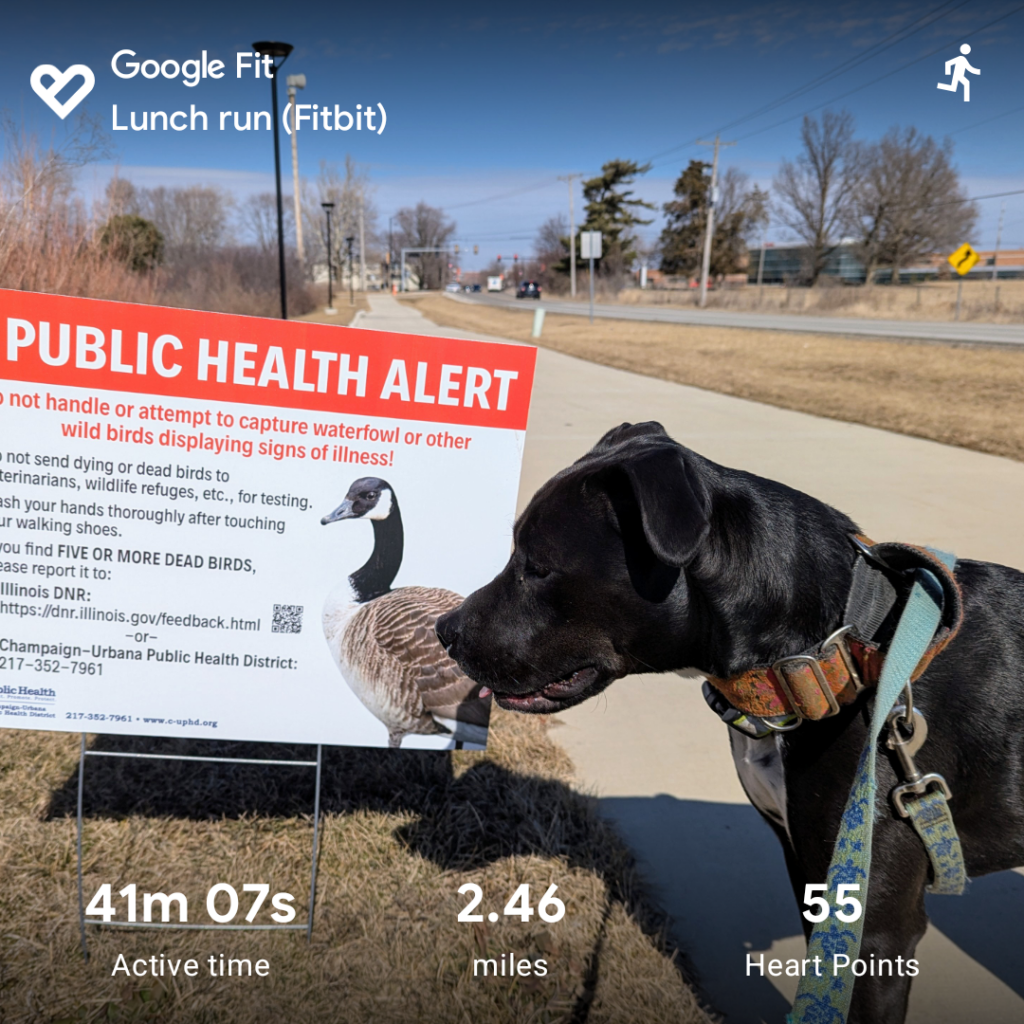

For most of my adult life, trying to use “intuition” to decide on rest days would have been a terrible idea. If I’d let myself say, “Hmm. I don’t really feel like a workout today,” I’d scarcely have worked out at all. Instead, I came up with a schedule, and stuck to it, either well or poorly.
When I stuck to it well, I’d see progress. When I stuck to it poorly, I wouldn’t.
Starting around 5 years ago or so, something changed in my brain: I started really enjoying my workouts.
Partially, it was that they were working well, which is just satisfying. But it was more than that. First, I noticed that I felt better after a workout. Then I started feeling better during a workout. Instead of it being hard to motivate myself to work out, I craved workouts.
People who knew me were mildly disturbed by this. It was unlike me. It was certainly unlike them. I would not be surprised if they began to suspect that I was some sort of pod-person.
Because I wanted to work out nearly every day, I would sometimes wonder if I was over-training (or under-recovering), but that’s not trivially easy to determine in the moment.
I’ve long tracked my workouts, but not really in a consistent way—I’d just write down what I did that day. Sometimes I could look back and say, “Wow. That looks like a serious workout,” and other times I’d look back and say, “Was that really a workout?” But often times it wasn’t clear either way.
Just lately though, I’ve been doing the Mark Wildman workout programs that I mentioned a few weeks ago. That gives me a pretty consistent metric. I’m doing three different programs, each of which has 4 to 7 different levels, each of which can be done with an almost infinite range of weights, but they all have a consistency in design: start with a light weight, work up in complexity, then bump up the weight but go back down in complexity. If you’re consciously attempting to make progress, then it’s pretty easy to make each workout “count” as a workout, while avoiding overdoing it in any particular workout.
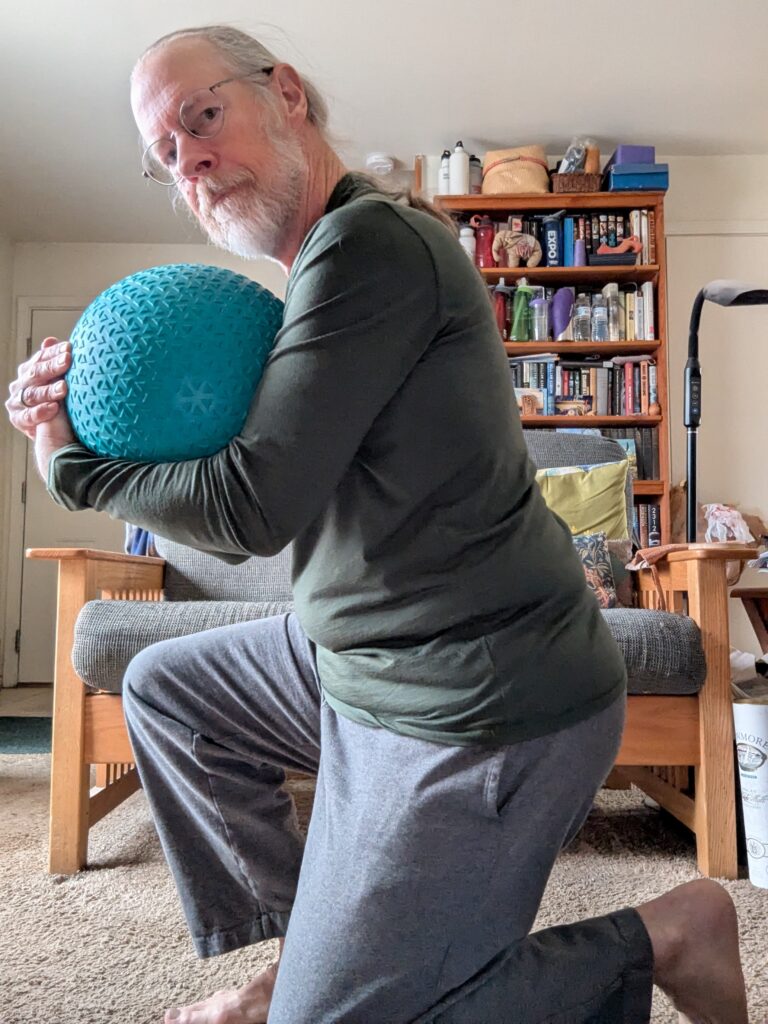
But while avoiding overdoing it in any particular workout is good, it is possible to do that, and yet get over-trained, simply by doing too many workouts with inadequate recovery.
So, today I went back over my past 3 months’ training log entries. For my first cut at this, I’m just counting rest days. I figure that I want to work out either 5 or 6 days a week, which makes any week where I have either 1 or 2 rest days a “good” week.
In the past 13 weeks I’ve had 1 week with 0 rest days, 1 week with 3 rest days, and 1 week with 4 rest days. All the rest were “good” weeks with either 1 or 2 rest days.
That’s just about perfect. The usual advice is to take a “deload” week every 4 to 6 weeks, so 2 weeks out of 13 being weeks with extra rest just about hits the nail on the head. The one week with 0 rest days was probably just an artifact of rest days falling outside of one calendar week—not a big deal, as long as it’s rare.
Anyway, the intuitive rest days seem to be working well. I’m getting in my workouts, and I’m getting in adequate rest. I guess I can stick with it for a while.
Zone-2 cardio has been having its moment. That comes from a lot of sources, but unfortunately a big one is Peter Attia. I say “unfortunately,” because Attia seems to have a weird, compulsive sense that zone-2 cardio work needs to be, I don’t know, pure in some way, rather than just being enough to promote good metabolic health.
Attia suggests that you do your zone-2 work on a treadmill, stationary bike, or rowing machine, so you can be in control of your effort level at all times. Then you can just get into zone 2 and stay there for 45 minutes.
I think this is crazy, and not just because 45 minutes of steady-state activity on a treadmill or stationary bike would be excruciatingly boring.
I do my zone-2 cardio with a mixture of walking my dog, running, and occasional hikes. Walking the dog isn’t perfect, because the dog keeps stopping to get in her sniffies, and no doubt my heart rate drops out of zone 2. Running isn’t great, because my heart rate probably spends a lot of time in zone 3 or zone 4. A lot of it is zone-2—at least, I can talk while I run, which is one of the tests for zone-2. (I run very slowly.) The hikes are probably perfect zone-2 cardio, but are a big time commitment in a single day.
Attia suggests that you optimize your cardio workouts by getting 3 hours a week of zone-2 cardio, which can optionally be divided into 4 45-minute workouts. And I’m sure that’s fine. But I suspect that getting in a couple of runs a week, along with a good bit of dog walking, is going to check the zone-2 cardio box no problem.
My theory (and I am not an MD, nor even a PhD in exercise physiology, but still) is that this is fine. You don’t need to get 45 minutes of pure zone-2 cardio to be metabolically healthy.
As I see it, the test for whether you’re getting enough zone-2 cardio is whether or not you can engage in a moderate level of exercise for an extended period—a 3-hour hike, let’s say. If you’re metabolically healthy you can go on and on at a moderate pace, because you’re doing it almost entirely aerobically.
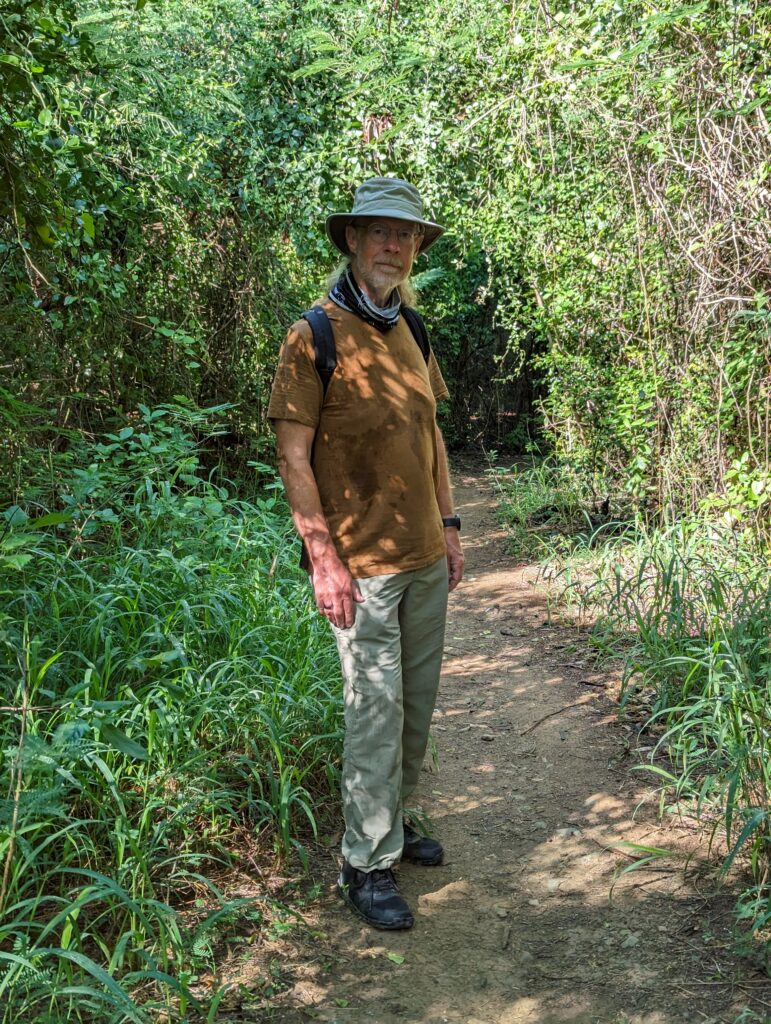
If you can do that, you’re getting enough zone-2 cardio, regardless of whether your sessions are 45 minutes long, and regardless of whether they add up to 3 hours a week. If you’re not metabolically healthy, even going at a moderate pace is going to push you into anaerobic metabolism, which will quickly become impossible to maintain.
It probably is true that you need to get in 3 hours a week if you’re going to be able to go on long, long hikes. But the idea that they need to be pure zone-2 sessions, rather than mixed sessions at all different levels of intensity, is just crazy.
About a decade ago, thanks especially to finding the work of Katy Bowman, but also from taking an interest in parkour and similar disciplines, I came to realize that movement was a better model for healthy activity than exercise.
Then came the pandemic.
For a lot of reasons—in particular, the loss of the opportunity for moving with a community—I found that returning to exercise suited me better, especially in the early days of the pandemic. (Follow that link for a pretty good post about where training falls on the movement vs. exercise spectrum.)
Over the past year I realized that it’s been five years now that I’ve prioritized exercise over movement, despite the fact that I still think that movement is the better choice. But when I started thinking that I should start trying to emphasize movement more again, I realized I already have been.
The biggest way that movement has snuck back into my practice is HEMA (aka sword fighting). There is some exercise involved in training for sword fighting, and it is certainly not a complete healthy movement practice all on its own, but it is moving, for a purpose, with a community—things I had been lacking for years.
The next biggest has been walking. In particular, dog walking. It’s not that walking has snuck back into my practice. I have always been a walker, and all that getting a dog changed was that now I walk every single day, instead of merely almost every day. (Even during bad weather, I average at least 12,000 steps per day. When the weather is nice, I top 15,000.) What having a dog changes is that now the walking is not exercise. It’s movement, because I’m doing it for a purpose that has nothing to do with “getting some exercise,” and rather is about making sure my dog is getting what she needs.
I still do some exercise. In particular, I’ve paid up for four workout programs by Mark Wildman: His two club programs two-handed and one-handed, his slamball program, and his “actual action hero” ab program. I skipped getting a kettlebell program (I’ve been doing kettlebells long enough that I feel like I know how to integrate them into a fitness routine, plus my sore elbow seems to be aggravated more by kettlebell moves than by club or slamball moves.)
I’m really pleased with the two-handed club program, which adds to the basic swinging moves a set of lunge moves, a set of squat moves, and a set of ab moves (that work toward a get-up).
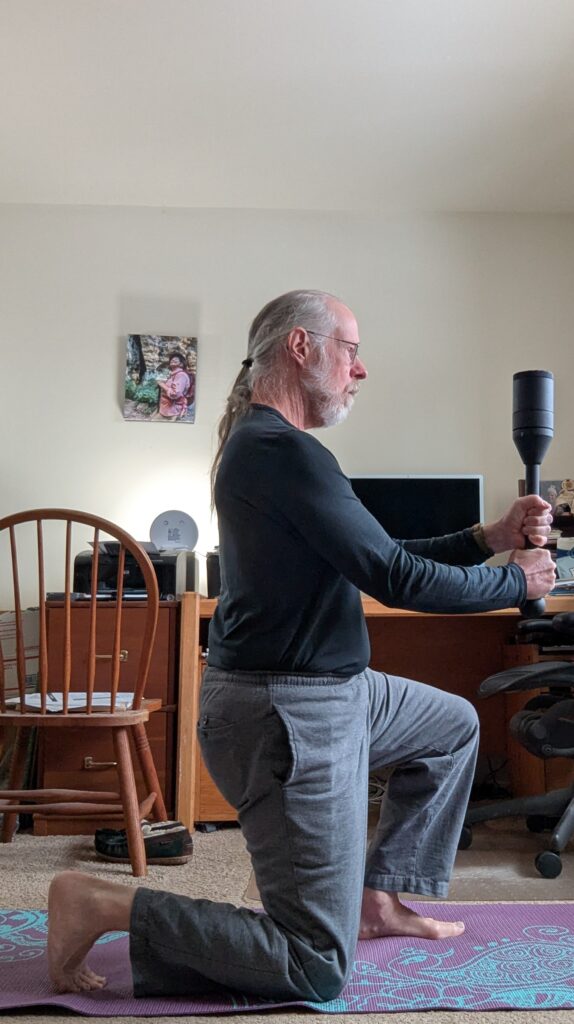
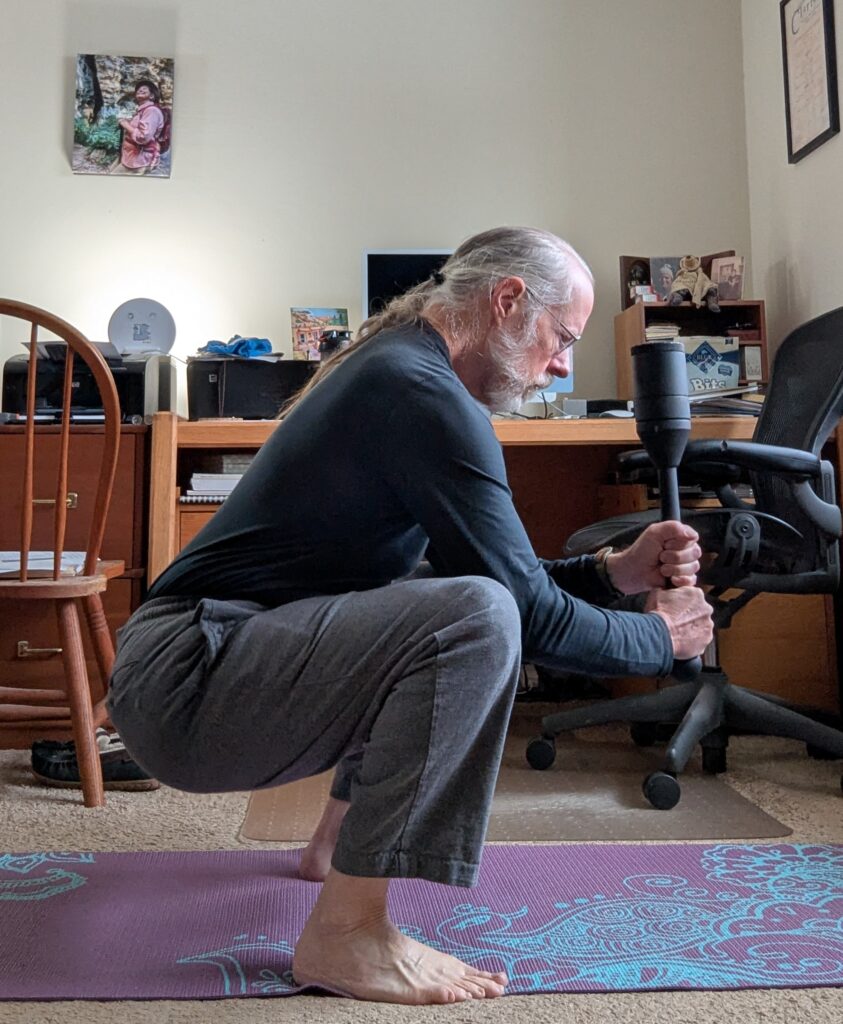
The one-handed club program is also good, but much more technical and specific. It’s purpose, I guess, is to improve your alignment and structure, which is cool (and which I expect will be useful for sword fighting), but it doesn’t look like it’s going to do a lot for overall fitness.
The ab program is interesting. Mark Wildman wrote it for his friends who are stunt people, who needed a program that could be done in a very small space (basically a yoga mat on the floor of a trailer, which is what stunt people live in on-set), that focused not on making your abs look good (although it definitely will) but rather on building the muscle, strength, and control to do the sorts of moves that stunt people need to do. It’s designed to be done in just a few minutes every day at the end of your usual workout. It has 50 moves, and it gives you a different combination of them every day for up to a year (assuming you can work up to doing continuous ab work for 14 minutes a day, five days a week.
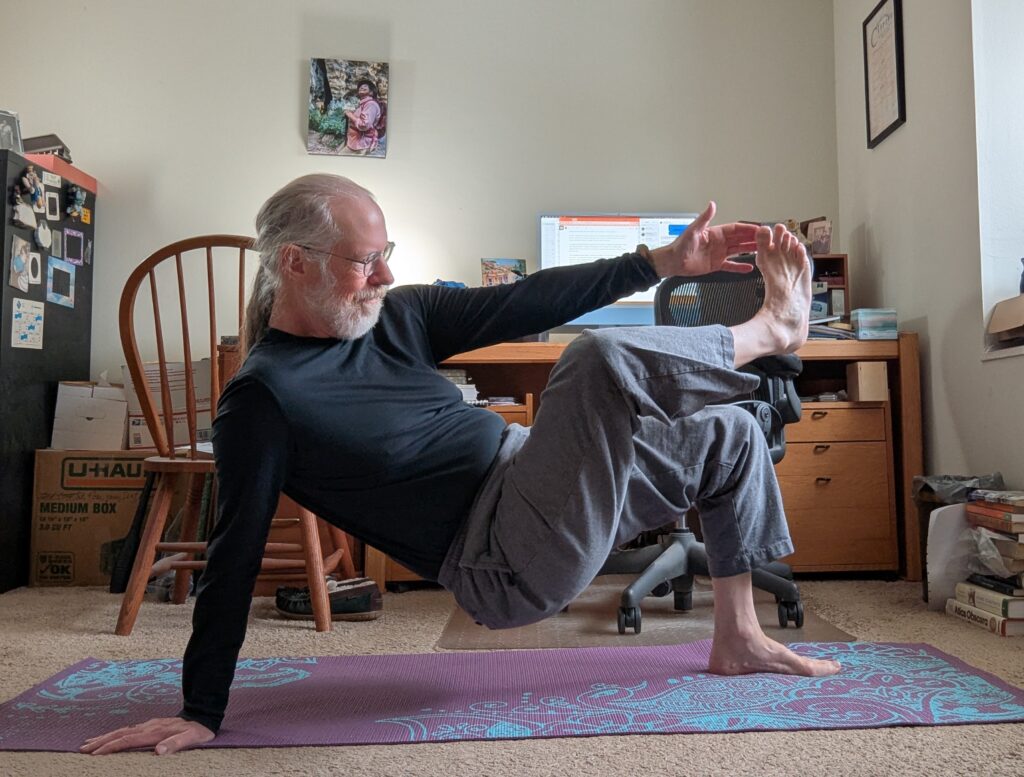
So, I do continue to exercise, because it seems useful, and it suits me, but I’m going to resume trying to prioritize movement going forward.
For much of my life I thought that the key to losing weight was just exercising more. Especially in the mid-1980s, when I lived in Utah and California, I’d get out for some long hikes in the mountains and deserts and think, “If I could just do this all the time, it would be easy to maintain a proper weight.” That turns out to be both true and false.
The fitness influencer types like to say things along the lines of “You can’t outrun your fork,” meaning that you simply can’t burn enough calories to get ahead of eating way too much. I knew that wasn’t completely true. Read about any long-distance endurance athlete (ultra-marathoner, Tour de France rider, etc.) and you’ll have a window into really extreme efforts to eat enough just to keep going, let alone enough to recover for the next day’s effort.
I also have a slightly more ordinary example. A couple of guys I knew tried to bicycle around Lake Superior and Lake Michigan, and had to abandon the effort halfway through, because their riding (100+ miles per day) burned so many calories (perhaps 5000 calories on top of their basal metabolic rate, so maybe 7500 calories per day total), they ran out of money for food.
It’s tough to eat 7500 calories per day even without the financial limit, so it seems like, if you have all day to do nothing but exercise, and the will to exercise hard for several hours a day, perhaps you could “outrun your fork.”
Recent research shows that this is not the case, except in the very short term. People who are very active all day, like hunter-gatherers (but also subsistence farmers, and laborers of other sorts), burn more calories than people who are sedentary all day, but only modestly more.
A recent study showed that among of Hadza people, activity was almost insignificant as a predictor of total energy expenditure. They were remarkably active, but their calorie consumption was pretty ordinary. The study suggests that body size is just about all that matters
In that study, average total energy expenditure among Hadza men was 2649 calories per day. The average is higher among western men, but only because their body size is greater. (Hadza men averaged 50.9 kg (112 lbs), while Western men averaged 81.0 kg (179 lbs). Differences in BMI are more stark, with Hadza men having a BMI averaging 20.3, while Western men’s BMIs averaged 25.6.)
The point here is that it seems like your biology is attuned to wanting to eat 2600 calories and wanting to burn 2600 calories. (Adjust for frame size. It seems the Hadza men averaged about 5′ 2″.) You can be sedentary, under-eat to match, and not gain weight, but it’s not in tune with what your body wants, so you’ll be hungry all the time, as well as having all the side-effects of under-movement.
You can also try to exercise enough to burn more than 2600 calories, but it seems that as soon as you go over that level, your body starts trying to compensate—turning down whatever is easy to turn down, such as your immune system, and muscle-building system.
That doesn’t happen immediately. If you go on a century ride you will burn the extra 5000 calories that simple arithmetic would suggest. That would probably continue if you went on a three-day bicycle tour. But pretty quickly—probably just in a week or so—less-essential body functions would ramp down (and of course fatigue would ramp up) bringing your total consumption back down toward 2600 calories.
You can see how this would work well for hunters. You go for a hunt one day (or two or three days), hiking or running for miles, finding prey, tracking it, and finally killing it. Then you (and your whole tribe) have lots of food to eat for a day (or two or three). During extended periods of excess activity maybe your immune system and muscle-building system ramps down, but then during periods of ample food and less activity, maybe it ramps up extra, allowing for full recovery.
Consuming more calories than you burn for more than a few days, however, quickly leads to problems. Increased fat storage is probably the least of them. Insulin resistance is another. Systemic inflammation is another. Those extra calories will go into the things that get turned down when you’re extra-active, such as the immune system. I don’t know that there’s any evidence, but an obvious possibility is that a lot of auto-immune disorders are just an immune system that never gets turned down because people are never active enough to burn more calories than they eat, if only for a day or two.
I think it’s true that you can’t out-exercise excess calorie consumption. However, you can definitely under-exercise—and trying to under-eat to match that will also cause problems. Humans evolved to thrive with an ideal level of activity.
It’s also true that you don’t need to hit that particular level of activity and food consumption every day. In fact, I’m sure you’d be better off to be moderately active most days, and then very active 1–3 days a week. My long-ago dream of being able to hike 10–15 miles every day and then eat all I want turns out to be a terrible idea. Rather, you want to walk 5 or 6 miles most days, and then hike 10–15 miles just once or twice a week. (Feel free to swap in bicycling or rowing or whatever you like for the long days of vigorous activity, although you probably want to keep in the basic walking if you possibly can.)
I’ve been thinking about longevity too long and too hard. It isn’t something that I suddenly started doing when I reached my 60s, or even when I hit middle age. I can remember as a high school student figuring out that I’d need to live about two thousand years to have time to learn and do all the stuff I wanted to learn and do.
Sadly, everything we know now suggests that lifestyle improvements can get you a life extension of 7 years—maybe as much as 11 years, if you get serious about it. I mean, that’s not nothing, but it’s not going to get me to two thousand years, or even to eleventy-one, like Bilbo. (That’s what I lowered my sights to, when I realized that two thousand years was unlikely.)

I was briefly pretty hopeful in the late 1980s, when it looked like nanotech might produce amazing longevity gains. But, no. Turns out except for a few materials-science things—stuff like that tweaking the surface of glass to make it self-cleaning—the only nanotech that anyone has been able to get to do anything remotely interesting is biotech. I mean, MRNA vaccines are awesome, but nothing like the nanotech we were promised.
Considering how much is written about longevity, the stuff that actually works offers pretty minimal benefits. Getting a life extension of 7 to 11 years look pretty easy, just by doing the obvious, boring stuff, and practically none of the fancy bio-hacky things have any evidence behind them at all.
So what are the boring things that work?
Don’t eat industrially produced food-like substances. Eat in reasonable amounts. Eat diversely. I saw one study that suggested that any exclusion-based diet—keto, carnivore, vegan, etc.—seemed to be associated with poorer health outcomes. (On the other hand, if one of those things produces benefits in the short term—for me, it’s eating low-carb—there’s no reason not to do it long enough to reap those benefits. But long-term you want a diverse diet.)
Until recently the only real evidence-based exercise advice was for 150 minutes per week of moderate-intensity exercise (brisk walking, basically). But recently it has become very clear that maintaining muscle mass, strength, and power are beneficial in multiple ways (everything from reducing falls to providing a glucose sink). Separately, a high V̇O2 max is strongly associated with a longer life. So although there’s little evidence for weight lifting, running, or high-intensity cardo, there is now very good evidence that the entirely expectable results of those exercise modalities are excellent for longevity. So: diverse exercise is going to help you live longer.
Really good diet and exercise can maybe eliminate the need for drugs. But taking the drugs if you need them can help a lot.
There’s good evidence of benefit from social connection. There’s good evidence of benefit from time spent in nature. There’s good evidence of benefit from having a positive mental attitude. (All those are suspect, because being sick makes them tougher to do, so you’re selecting out some fraction of the people who are going to die young, which makes the statistics misleading. But there’s not much point in a long life unless you’re going to enjoy it, so why not?)
I’ve refrained from mentioning the bio-hacky stuff that I’ve spent way too much time thinking about. Not just the nanotech stuff, but also all the rest: All of the supplements, sleep hacks, drinking more (or less) coffee (or tea or bone broth or mushroom-enhanced beverages), etc.
It’s not that things like sleep aren’t important. It’s that there’s essentially no evidence that any specific intervention is going to help in a measurable way. In fact, there can’t ever be any such evidence. The experiment can’t be done. And if it were done, the effect wouldn’t be measurable.
I mean, if you have a diagnosis for a problem—sleep apnea, for example—then treating that problem could very easily be transformational, not just for your longevity, but for your life right now. But giving everyone a CPAP machine would do no good. Furthermore, picking a few random sleep hacks—avoiding caffeine after mid-day, wearing blue-blocker glasses, or tweaking your pre-bedtime routine—isn’t going to make any difference across the population. (Any one of those might help you in particular, and if it does, more power to you. But none of those, even if adopted by 100% of the population, is going to add a year to the average lifespan.)
If you’re interested in details, you might look at the recent New York Times article “The Key to Longevity Is Boring.” Another option would be to read the Peter Attia book Outlive, or listen to his most recent podcast episode, Longevity 101, either of which does a great job of covering the handful of things that will give you that extra 7 to 11 years of life.
All consumer-grade heart rate monitors have issues. Chest straps are pretty good. The optical captures from wrist (Google Pixel watch, etc.) or finger (Oura ring) are quite a bit less accurate.
I’ve generally just tolerated it—taking the reported data with a grain of salt—but sometimes it would be nice to get good data. Today I did a little experiment with my Google Pixel watch—tightening the strap at the midpoint of my run—and found that it seems to give me pretty good data this way.
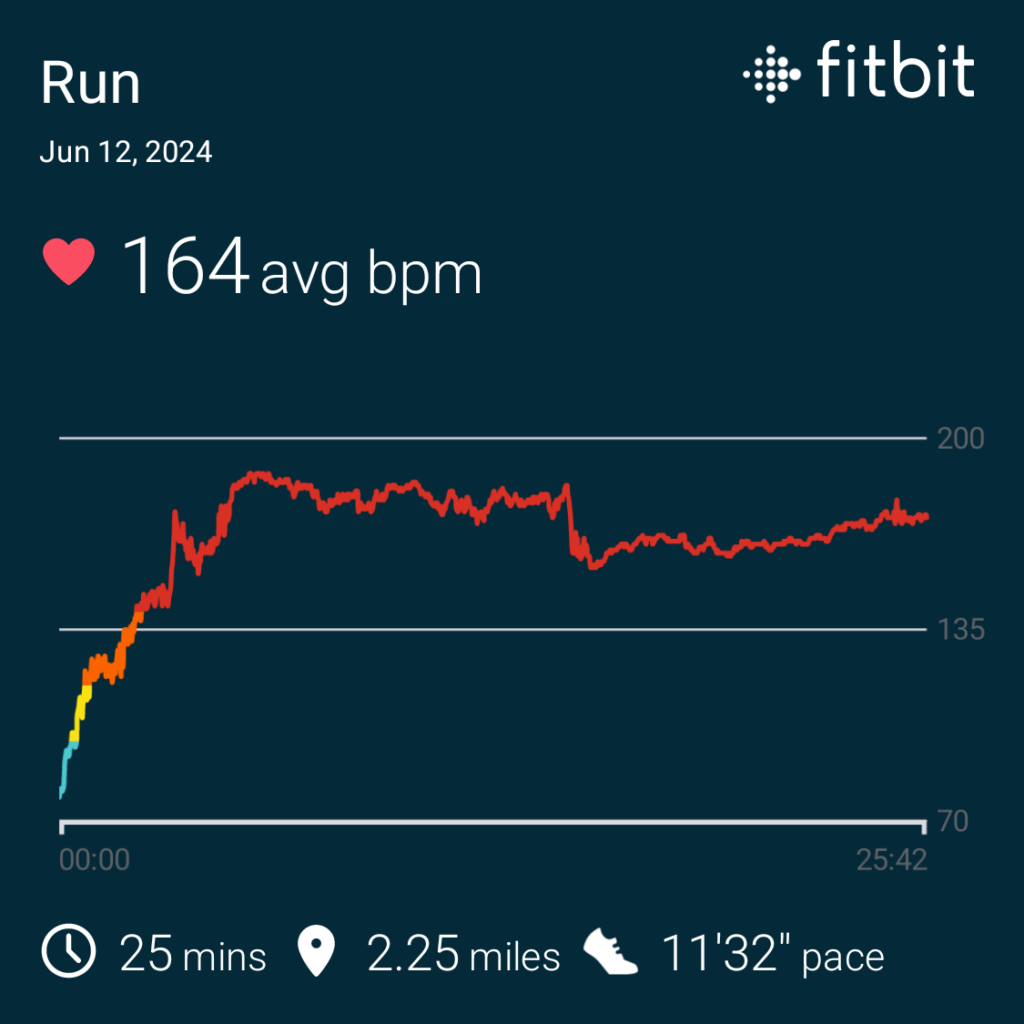
What you see is my warm-up, followed by 1 mile out and then 1 mile back. The HR shown for the “out” phase (averaging maybe 180 bpm) is ridiculous—what it’s capturing is not my HR, but rather my step rate.
In the second half my HR goes from about 160 to slightly above 170 (gradually rising as I get tired), and that’s probably just about right.
(The standard formula for estimating your maximum heart rate is 220 minus your age, which would give a max HR of 156 for someone of my age. But that’s clearly wrong for me. I pretty regularly see peak HRs of just over 170 that seem entirely legit. I assume that my genes and my training history just give me a higher max HR than typical. Sadly, it doesn’t make me faster, as you can see from my average pace for this run. I was running literally as fast as I thought I could maintain for 2 miles.)
Anyway, I think I can recommend tightening up the Pixel watch band as tight as tolerable, for getting the most accurate data.
Me and Ashley, out for a #run. Once again, she’s a much better running companion than she is portrait model. 🏃🐕 #dogsofmastodon
Because of dog-related complications, I didn’t get good stats on the run, but it was about 2 miles and maybe 30 minutes (including time to water the dog and pose for photos).
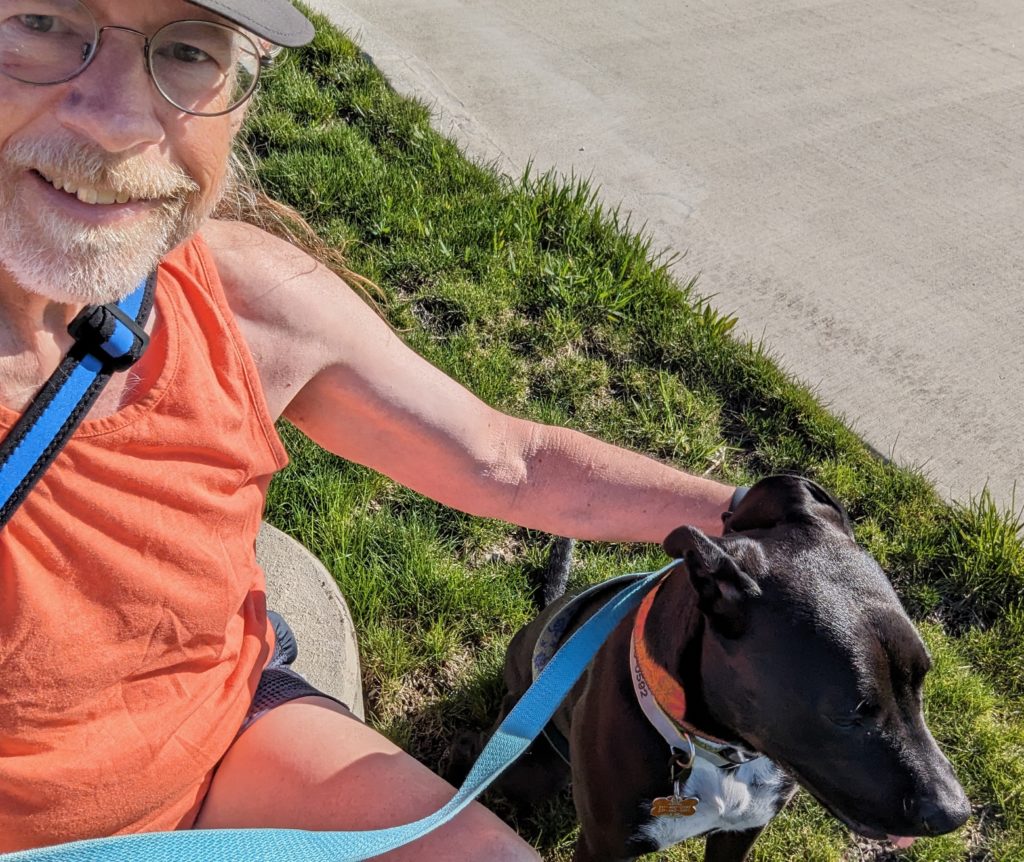
The books say not to take your dog running until they’re at least a year (better: 18 months) old, so they’re running on mature bones and joints.
Early on, I instead let Ashley take me on runs, letting her drag me on the leash while she sprinted off in random directions at breakneck speed for 30 or 40 seconds, only to cut in front of me and then come to an abrupt stop. It wasn’t really satisfactory. After I fell and badly split the skin on my knee, I mostly quit doing that. If I wanted to go for a run, I’d leave the dog behind with Jackie and run by myself. But that was unhandy for all of us.
Now that it’s spring, and we’re getting some nice running weather, I thought I’d see if Ashley could run with me.
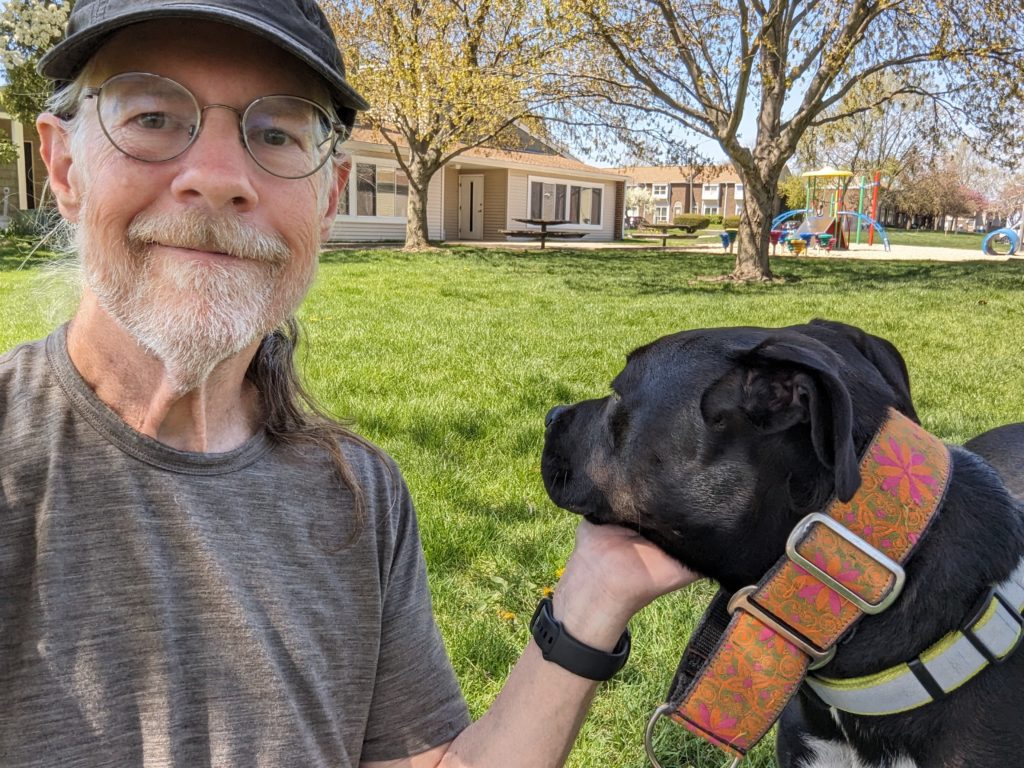
I’d done some preparation: In the winter I took a “loose-leash” walking class, and she’d gotten a lot better at walking with me. For loose-leash walking I wrap the leash around her chest and then back through that loop you can see on the collar in the picture. That has a couple of positive effects: the leash is effectively shorter, and when she does pull, the friction from the leash constricting around her chest makes the pull gradual, rather than an abrupt hard yank. The key, though, is that it serves as a signal that I want her to walk like a pet, and stay by my side, and she’s gotten pretty good at doing so.
Yesterday I thought we’d give running together a try, and it worked great! I walked her a few blocks on a long leash, so she could get her sniffies in. Then, once we reached a multi-use path that’s about a quarter mile away, I put her on the leash wrap, and started running—and she did just what I wanted her to! She ran along, next to me, at my pace. She didn’t try to run off in some other direction. She didn’t try to sprint ahead. She didn’t lag behind like she didn’t want to run. She just loped along next to me.
It was great!
I had neglected to bring water for her, so I was a little worried that she’d overheat, but she seemed to do okay. We ran a mile, then turned around and walked partway home, but when it seemed that she wasn’t overheated, I picked up the pace again and we ran the rest of the way back to our starting point, then I put her back on a loose leash and we walked home (where she did proceed to drink a whole bowl of water).
For future runs I will bring water. I’ll also make a point of getting out early, before the weather gets hot.
If this doesn’t turn out to be a one-off thing, and she’s willing to run with me on a routine basis, I’ll start taking her running every other day, sticking to short runs for a while to make sure we don’t over do it, then gradually increase the distance until one or the other of us hits some limit or another. (I’ve been routinely walking her over 6 miles nearly every day, so we’re both already in pretty good shape.)
A great #run! 🏃 My feet and knees felt great throughout. And it looks like the weather will finally support getting out twice a week. (This was my “long” run. I also want to do a “fast” run.)
